UC Blogs
Lurking in the Orchid Cactus
It's Veterans' Day, but to jumping spiders, it's just another day--another day to ambush unsuspecting prey. We spotted this jumping spider on an...
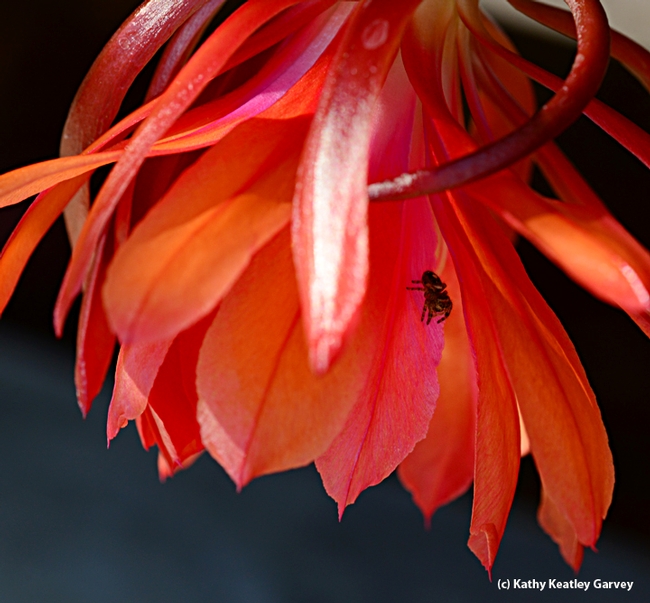
A jumping spider on an orchid cactus, Epiphyllum. (Photo by Kathy Keatley Garvey)
A Gathering of Entomologists
The Lone Star State will be far from "lone" or "alone" Nov. 10-13. Some 3000 researchers, professors, graduate and undergraduate students,...
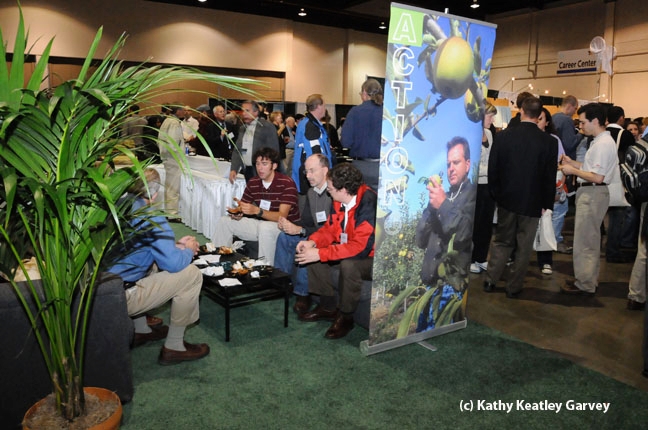
This was a scene from ESA's 2008 annual meeting, held in Reno. (Photo by Kathy Keatley Garvey)
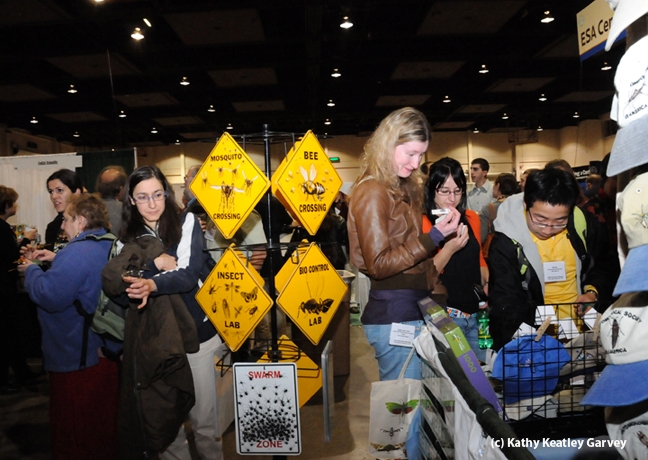
Signs of the times--at 2008 ESA meeting. (Photo by Kathy Keatley Garvey)
A Mockingbird Can Change Your Tune
Until last year, the noisy Northern Mockingbird (Mimus polyglottos) irritated me. Flitting from limb to fence to rooftop, this shrill impersonator of other birds’ song and sounds was not welcomed in my garden. But that was before a family of 10 moved into the neighborhood right across the street from my house and brought with them four felines that roam free 24-7. Needless to say, these cats prowl my front, side and backyard for birds. Within days, the seed feeders I had tacked atop fence posts and the bird baths I'd placed in the flowerbeds sat empty. No Towhees, Gold Finches or Robins. No Quail or Doves. Not even a Blue Jay or House Sparrow.
Now when I sat at my kitchen table sipping my morning coffee, I look out the window at cats slinking along the header of the wooden fence. Instead of enjoying the daily ritual of birds scratching the soil and sifting through leaves for insects, I see cats hiding behind bushes hunting for a feathered meal. Four uninvited cats licking their chops and leaving behind their business. Needless to say I'm one unhappy gardener. Yet what bothers me most is that I miss the twitter and squawk, the chatter and the chirp of bird song.
Until yesterday, I thought my days of listening to cheeps, coos and trills are history. Then out of the blue, a “many-tongued mimic” flitted into my backyard. Guess what? I was so excited to see a Mockingbird that I vowed never again to grouse about its mating call, even it woke me up at 2 a.m. This weekend I plan to rummage through the garage for paint to construct a small garden sign that reads:
ALL feathered friends welcomed here — even Mockers, Mimics and Misfits
Here are a couple of tidbits you might find interesting about the Mockingbird.
• The Latin name (Mimus polyglottos) really does mean “many-tongued mimic.” Recognized calls of the Mockingbird are: Hew call used to warn of nest predators and interaction between mates. Chat (used year-round when disturbed) or chat burst (specific to fall and used in territorial defense). Nest relief call and the begging call (used only by males).
• An omnivore that forages through vegetation and on the ground. Both male and female look alike, nest build, and are socially monogamous.
• The State bird of five states, known for its ability to recognize previous threats and intruders (including humans) and to return to prior breeding grounds. Today more Northern Mockingbirds live in urban habitats than rural areas and are considered a positive species.
For me, the very presence of this fascinating intelligent bird triggers an age-old in-depth conversation. Personally, I am at a loss for words, a good thing lest I write something naughty about the neighbors. Certainly, the Mockingbird’s reappearance in my yard is helping me change my tune about this amazing bird. But I can’t say the same about the cats. As a former “responsible” cat lover-owner who appreciates pets, I must be honest about these neighborhood free roamers. Seems to me that gardeners have little voice on the block to truly convey the environmental, emotional and spiritual impact of losing the sweet simple melody of their garden.
Yet maybe, in time, with enough cats as mentors, Mockingbirds will learn to meow. Now that’s a thought to ponder. I mean, can you imagine a 2 a.m. repertoire of screeching feline frenzy?
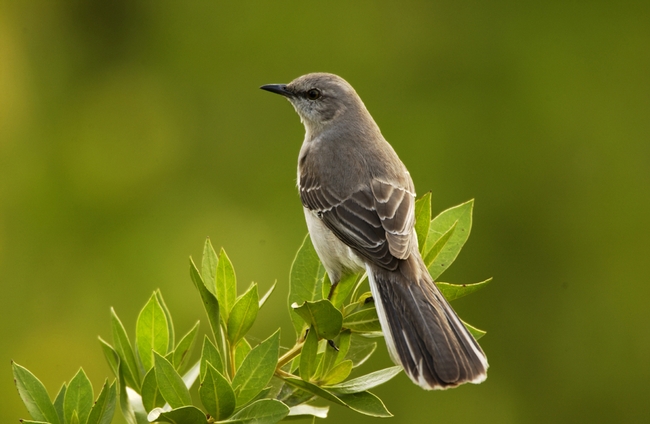
Mimus polyglottos (courtesy of Wikipedia.org)
Generating energy from forest products
Thinning a forest of woody materials has multiple objectives. It can increase the resiliency of the remaining trees from the effects of fire, drought, pest and disease; it can improve habitat quality for wildlife including watersheds; and it can make it easier for firefighters to protect human lives and livelihoods when a fire is burning. There are several ways thinning is carried out: cable logging, feller bunching, conventional tractor skidding, hand-thinning and piling, and mastication. One of the issues with thinning is the disposal of biomass that is non-merchantable (e.g., branches, tree tops, small diameter trees). Typically this material goes into large slash piles. For the most part, these piles are left in the forest to break down naturally under winter rain and snows, and are later burned. Because of strict air quality rules, forest managers have very small windows of opportunity to burn these piles, so they are often left on the landscape for many years, sometimes becoming a fire hazard themselves.
Forested communities are searching for ways to deal with this residual biomass that will improve the health of the forest ecosystem; improve and protect critical watersheds and wildlife habitat; reduce the amount of air pollution by removing the piles instead of burning them; and reduce the critical fire danger to their communities. The Placer County Biomass Program is taking up this challenge by chipping the slash piles and trucking the chips to a biomass facility to be converted into electricity.
Outside of Foresthill, Calif., the Tahoe National Forest American River Ranger District and the Sierra Nevada Adaptive Management Project (SNAMP) have been collaborating on a study of forest fuels reduction treatments carried out on national forests. The eight-year ‘Last Chance’ study involves independent third party research by University of California scientists of the integrated effects of forest thinning on fire hazard, forest health, wildlife, water quality and quantity, and public participation. The Placer County Biomass Program, in conjunction with the Tahoe National Forest, the Sierra Nevada Conservancy (SNC) and the Placer County Air Pollution Control District, proposes to remove some of the biomass waste from the Last Chance project to provide an alternative to open burning of the piles. Local contractors are hired to grind the material on-site, load the material into chip vans, and bring the material to market within 60 miles of the Last Chance site to create green, renewable electricity. Placer County estimates that roughly 3,000 Bone Dry Tons (BDTs) of biomass can be removed. According to UC researchers, one BDT burned in a typical commercial boiler fuel will produce 10,000 pounds of steam and 10,000 pounds of steam will produce about 1,000 horsepower or generate 1 megawatt hour (MWH) of electricity.
The economics of this project will be used as part of the assessment of locating a biomass energy facility in the Foresthill area. The removal of these biomass piles will greatly reduce the possibility of catastrophic fire to the local communities on the Foresthill Divide. The improved forest and watershed health will be noticed by the local community and the surrounding county which derives recreation and watershed benefits from the American River area. In addition, several tons of air pollutants will be avoided by removing the pile burns from this area which is currently a federal non-attainment basin that carries both business and health risks to the local population.
Though this project is of benefit to the Foresthill community, other communities in the wild-land urban interface aren’t as lucky. According to Brandon Collins, research scientist at the Pacific Southwest Research Station and UC Berkeley, the lack of funding to chip and remove slash piles and the lack of infrastructure or facilities to take the chips to, makes it impossible at this time to remove that biomass at a larger scale.
“There is so much woody material on the landscape as a result of fire exclusion, it could take decades to really get a handle on it," Collins said. "However, any effort to remove thinning residues from the forest and to also get a benefit from it, such as energy, is great and should be supported.”
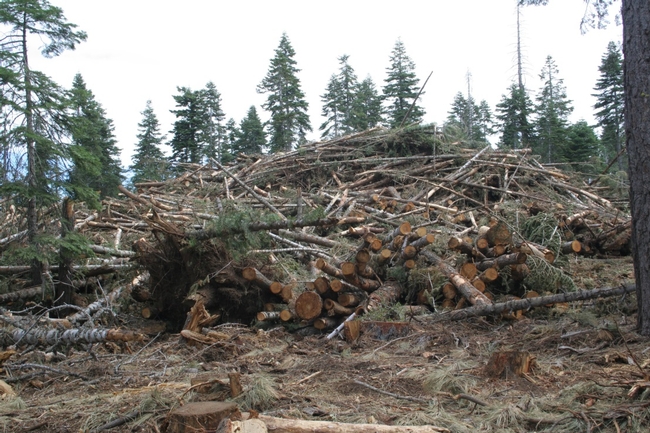
Slash pile in Tahoe National Forest, Last Chance project.
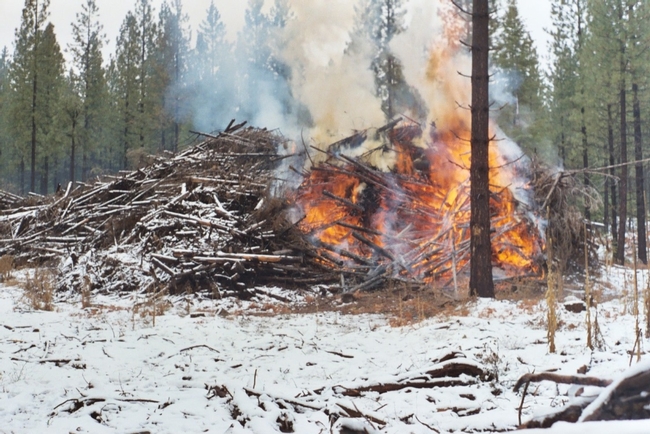
Slash pile under a controlled burn.
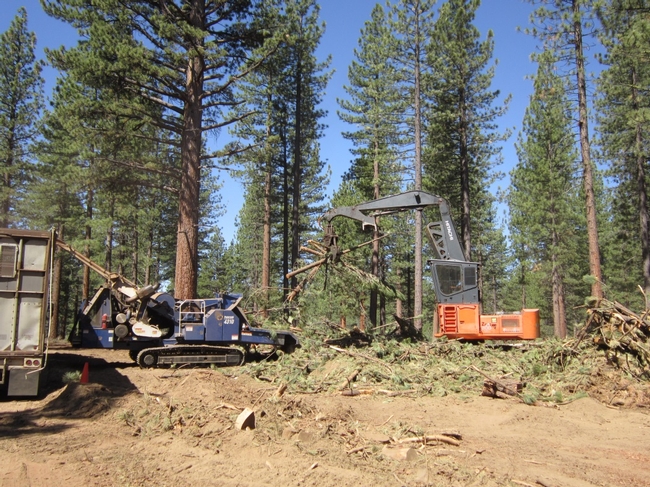
Workers bunch slash.
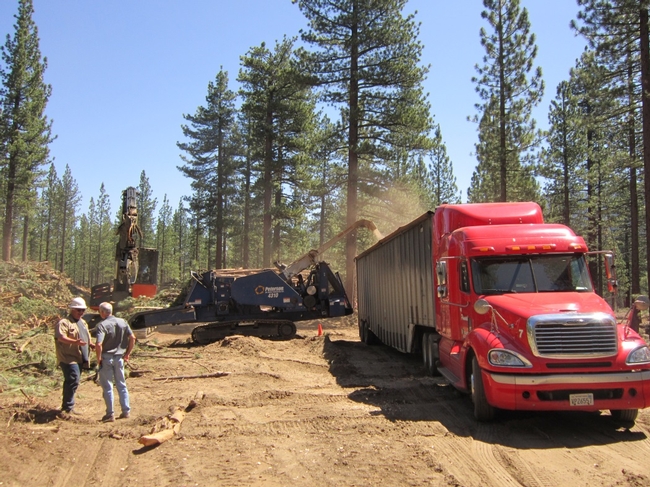
Slash piles are chipped and trucked to biomass facility.
Honey Bees and Extinction
"Would the extinction of honey bees lead directly to the extinction of humans?" That's a recent question posed on Quora, where folks can ask...
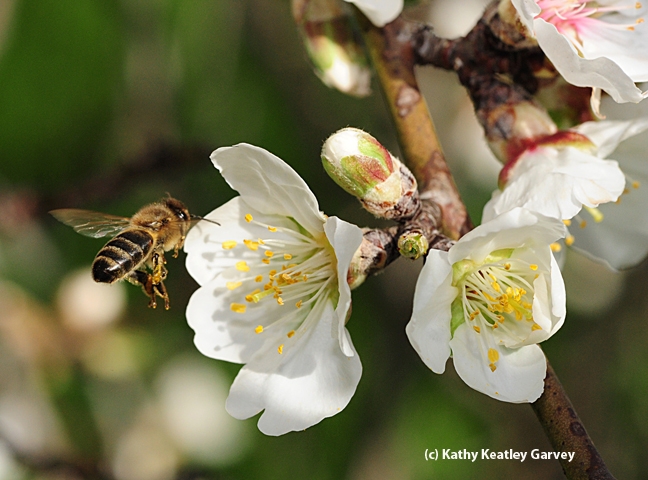
A honey bee heading toward almond blossoms. (Photo by Kathy Keatley Garvey)

